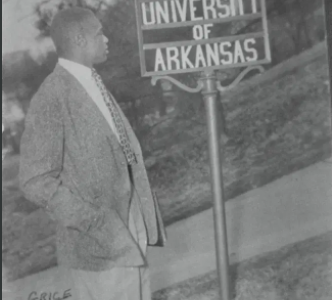Just as members of FUPC were involved in the desegregation of Fayetteville High School, the church also supported the desegregation of the University of Arkansas. From A Light on the Hill:
University of Arkansas Integration and Local Presbyterian Support
From the fall of 1948 to the fall of 1950, five black students entered the University of Arkansas School of Law. They were Wiley Branton, George Haley, George Howard, Christopher Columbus “C.C.” Mercer, and Jackie Shropshire. These five men followed in the footsteps of Silas Hunt, who had enrolled qt the law school in January 1948, the first black student to attend a major all-white Southern university. Hunt was forced to withdraw from school due to illness and died in 1949. The six law students would later be referred to as the “Six Pioneers.”
Shropshire was the second black student to be accepted into the School of Law; he was required to site in an area of the classroom separated from white students by a railing. Professor Wiley Davis (husband of FUPC member June Davis) led a faculty group that threatened to resign if the barrier was not removed. It was!
When C.C. Mercer received the Silas Hunt Legacy Award given by the university in 2012, he mentioned several who had the courage to support the Six Pioneers. In his acceptance remarks, he specifically noted that the Presbyterian Student Center and its director, Rev. William Gibson, along with sociology professor Stephen Stephan (longtime FUPC member) and students Marge and Eck Rpwland, had the courage to support the six students. Mercer also recalled Professor Stephan “going out of his way” to provide the students with a reception after a campus talk by Dr. Ralph Bunche, thge first African American Nobel Laureate who also served as assistant secretary-general of the United Nations.
In Judith Kilpatrick’s book, There When We Needed Him: Wiley Austin Bronaton, Civil Rights Warrior, Branton is quoted: “The student religious groups, for the most part, shared the general aversion to integration. The men were Baptist and Methodist and should have been eligible to join those student religious groups, but they were rejected. Instead, with the encouragement of Rev. William Gibson at the Presbyterian Student Center, and after an affirmative vote of the white student membership, the six were invited to join Westminster House in February 1951.” Branton would later say that the six “had to be Presbyterians if they wanted any religious experience on campus because it was the only group that would admit them.” The student center became a refuge for the men — the one place where they could act normal and not feel on display.
Several of the Six Pioneers continued to be active Presbyterians, and all had illustrious law careers. Branton and Mercer were attorneys for the Little Rock school integration of 1957. Branton later became Dean of the Howard Law School, and was a well-received author. He also held a position in the federal government under President Lyndon B. Johnson. Mercer was a field director for the NAACP in Arkansas and was an aide-de-cap for civil rights activist Daisy Bates. He helped transport the “Little Rock Nine” to and from Central High School in 1957. George Haley (brother of author Alex Haley) served as Deputy Attorney for Kansas City, Kansas, and was legally involved in the landmark Brown vs. Board of Education case. He later served as ambassador to The Gambia and held several positions in the federal government under seven presidents. George Howard continued hois civil rights activities with the NAACP on the state and national level and became the first African American federal judge in Arkansas. Shropshire engaged in the practice of law in Little Rock for five years before moving to Gary, Indiana. The five graduates — plus Hunt — all made their mark in the field of law and in efforts to eliminate inequalities for African Americans.


